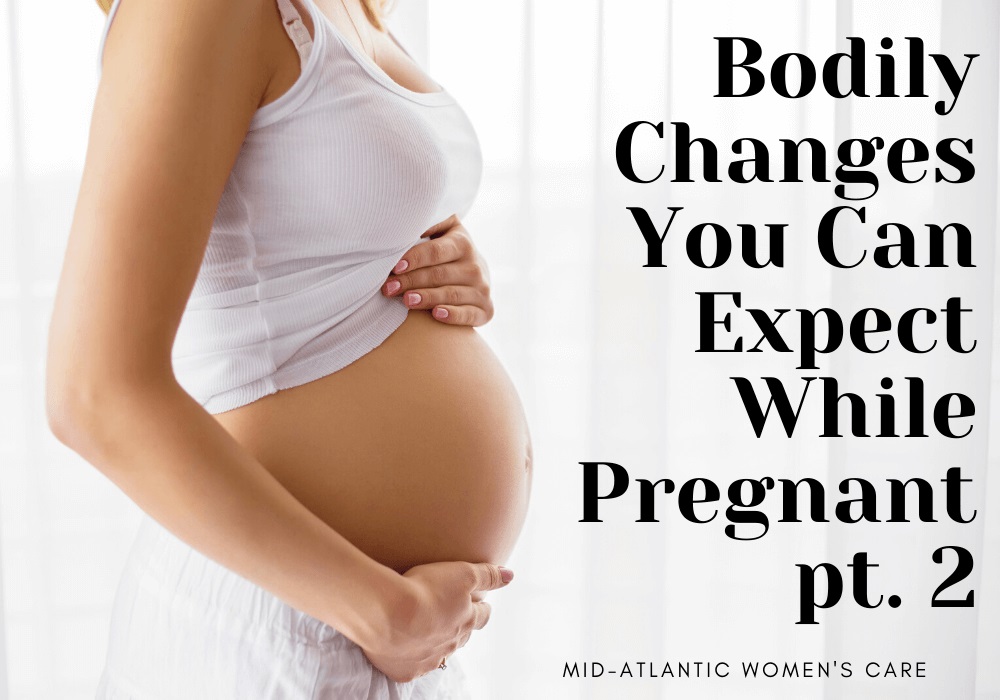Last month, we wrote about sensory changes, hormonal changes, and changes in the breasts and cervix that can impact a woman during pregnancy. Upon writing that article, we knew we wanted to write a more comprehensive guide to what you might experience during pregnancy so that you’re ready for all the possible changes that you may go through.
Respiratory and metabolic changes
Pregnancy causes an increase in the amount of oxygen transported in the blood due to the increased demand for blood and the dilation of blood vessels. The growth forces an increase in metabolic rates during pregnancy.
Metabolic rate
The amount of energy the body expends while at rest increases dramatically during pregnancy. It’s important to monitor this rate, the resting metabolic rate (RMR), in order to estimate the amount of energy intake required to maintain or gain weight. The change in this rate is why pregnant women need to increase calorie consumption.
Changes in body temperature
A slightly higher core temperature is a common sign of pregnancy and will be maintained through the duration of the pregnancy. Women will also notice a higher need for water as they are at greater risk of hyperthermia and dehydration and need to be cautious to remain hydrated.
Breathing and blood oxygen levels
A pregnant woman moves 30-50% more air in and out of her lungs than a woman who is not pregnant due to 2 factors: 1) Each breath has a greater volume of air, and 2) The rate of breathing slightly increases. Even without exercising, these changes can cause shortness of breath.
Changes in hair, skin, and nails
You will likely experience changes in the physical appearance of your skin while pregnant. Most are temporary (stretch marks, for example) while others can lead to permanent changes.
Hyperpigmentation
The majority of pregnant women experience some sort of hyperpigmentation which consists of the darkening of the skin tone on parts of the body including the areolas, genitals, scars, and the linea alba, the dark line that forms down the middle of the abdomen. This occurs in women of every skin tone but it’s particularly common among women with darker complexions.
Pregnant women may also experience a condition called melasma with the darkening of the skin on the face. This condition is worsened by exposure to the sun and its radiation so it’s essential to we broad-spectrum sunscreen daily during pregnancy. Melasma typically goes away after pregnancy.
Changes in moles and freckles
The hyperpigmentation will likely also cause darkening in moles, freckles, and birthmarks but these changes are typically harmless. If, however, you do notice changes in size, color, or shape, you should visit a dermatologist or your OB. Most skin pigmentation changes will fade or disappear postpartum but changes in mole and freckle color are often permanent.
Stretch marks
Nearly 90% of pregnant women will see stretch marks form on their bodies by the 3rd trimester as a result of the physical stretching of the skin and the effects of hormone changes on the skin’s elasticity. These most often form on the breasts and abdomen and while they will likely fade in color, they may never disappear fully. Stretch marks may itch so applying a cream can reduce the itchiness and deter you from scratching and potentially damaging the skin.
Changes in hair and nails
Hormone changes that occur during pregnancy can lead to excessive hair loss, particularly in women who have a family history of alopecia. Many women, however, experience hair growth and thickening at rapid rates and may even notice more hair growing in unwanted places, the face, arms, legs, or back for example.
These are changes that typically return to normal after the baby is born but it’s common that women will continue experiencing hair shedding and loss up to a year postpartum. This happens because your hair follicles and hormone levels are trying to regulate themselves again now that they’re no longer under the influence of pregnancy hormones.
Many women will also experience faster-growing nails while pregnant, due in large part to the prenatal vitamins that add to the growth hormones of pregnancy. This can also come with increased nail brittleness, grooves, keratosis, and breakage.
Circulatory system changes
Due to the rapid expansion of the blood vessels and increased strain on the lungs and heart, women produce more blood during pregnancy and must, therefore, use more caution when exercising. They may experience the following during pregnancy:
- Heavy breathing while exerting energy, like climbing the stairs or exercising
- A feeling of dizziness when standing quickly
- Changes in blood pressure
Blood pressure and exercise
Pregnancy hormones can have a sudden effect on the tone in blood vessels which results in that dizzy feeling or brief loss of consciousness that is relatively common among pregnant women. This is caused by the loss of pressure sending less blood to the brain and central nervous system.
Dizziness and fainting
Dizziness is more common after the 24-week mark or earlier in multi-fetal pregnancies and conditions that increase amniotic fluid. Lying flat on the back compresses the large blood vessel that goes from the lower body to the heart which can cause a sudden and dramatic decline in blood pressure, causing dizziness or loss of consciousness.
To avoid this, we recommend that after the first trimester, avoid exercises that require lying on the back. Lying on the left side may help relieve dizziness and is a good position to sleep in. If you are consistently experiencing dizziness or fainting, you should consult with your doctor.

